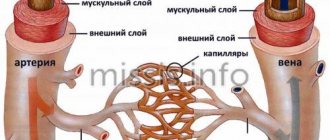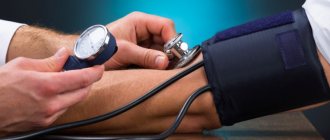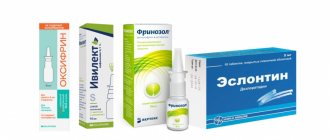Early postoperative period
Wound care. Typically, postoperative sutures do not require removal, and the wound does not require special care. The doctor may recommend that you treat the wound with brilliant green for several days, in most cases this is enough. However, you need to protect the wound from injury, avoid rubbing the wound with clothing, and avoid hypothermia.
Shower. If sutures are not required or are removed, you can shower. Hot showers are not recommended. The wound is washed with warm water without using a washcloth. After washing, you need to blot the wound area with a towel, do not rub! After the wound has dried, you can treat it with brilliant green.
Mode. During the first month after surgery, a gentle regime is necessary. The wound must heal, and the body “get used” to the new features of the blood supply. Therefore, physical activity, baths, saunas, hypothermia are not recommended, and alcohol intake should be completely avoided.
Medicines. After the operation, you will be prescribed medications. Strictly follow the regimen and dosage. More information about medications will be discussed below.
Grounds for issuing a certificate of incapacity for work
Myocardial infarction is an acute condition that threatens not only the health of the patient, but also his life, therefore, any person who applies to a licensed medical institution for medical care has the right to issue a sick leave certificate and receive temporary disability benefits if he is insured in system of compulsory health insurance and is an employee in the sense provided for by the Labor Code of the Russian Federation.
In this case, the basis for issuing sick leave is a combination of the following factors :
- the occurrence of an insured event in the form of a myocardial infarction, certified by a doctor at a licensed medical institution;
- insurance of a person in the compulsory medical insurance system;
- the sick person is a person who is in an employment relationship with the employer in accordance with the Labor Code of the Russian Federation (this fact is not subject to any verification and the patient’s oral statement is sufficient for the health worker).
Myocardial infarction is a serious disease in itself, in which the doctor opens a certificate of incapacity for work absolutely , and if surgical intervention is necessary to treat it (which happens in the vast majority of cases), it is all the more impossible to do without a certificate.
What to do to avoid repeated operations?
Most people know what a healthy lifestyle is, that smoking, overeating and lack of exercise are harmful to health. Following simple rules (see the article “Prevention of Atherosclerosis”), which should become a habit, will help not only to avoid repeated operations, but to maintain health for many years.
Lifestyle
An active lifestyle is very important, not only for the prevention of atherosclerosis, but for maintaining health in general.
It is important for post-surgery patients to choose the right type of exercise. This is primarily walking, doing housework, gardening, or climbing stairs. You can work out in the gym (physical therapy), swim. But it is important to remember that exercise associated with heavy sweating (when you sweat a lot) is undesirable. If they are unavoidable, always keep a water bottle with you.
Diet
It is necessary to form the habit of healthy eating. Changing your diet is essential to normalize your weight and reduce your cholesterol levels, which play a huge role in plaque formation.
Medications
Taking medications after arterial surgery is extremely important. This should become a daily habit. In order not to forget to take a pill, you can use, for example, a reminder on your phone.
The main medications that need to be taken after artery surgery are “blood-thinning” drugs (antiplatelet agents and anticoagulants). Taking these medications will help avoid thrombosis of the reconstruction area. Therefore, strictly follow the dosage regimen and dosage. Under no circumstances should you stop taking these medications on your own. However, taking “blood-thinning” drugs can provoke various bleedings (nasal bleeding, menstrual bleeding, bleeding gums, spontaneous formation of hematomas, and so on). If signs of bleeding appear, you should immediately consult a doctor. If you see another doctor, such as a dentist or gynecologist, be warned about taking “blood-thinning” medications.
To prevent further development of atherosclerosis, drugs are prescribed to lower cholesterol levels ().
Bath, sauna
The steam room is not recommended for patients after arterial surgery, especially in combination with alcohol. The fact is that in the steam room a person sweats and loses a lot of fluid, which leads to “thickening” of the blood and can provoke the formation of a blood clot, especially in the operation area. The same applies to any situations in which increased sweating occurs (physical activity, hot weather, etc.). If such situations are unavoidable, always keep a water bottle with you.
Alcohol
Excessive alcohol consumption is a risk factor for the development of thrombosis of various locations, even in a healthy person. As for the patient after arterial surgery, alcohol abuse greatly increases the risk of developing thrombosis of the arterial reconstruction zone. Most patients with atherosclerosis after artery surgery completely refuse to drink alcoholic beverages.
Visit doctor
Regular visits to the doctor and additional research methods (blood tests, ultrasound, etc.) will help avoid unfavorable situations.
Don't neglect your health.
Visit your doctor regularly and follow all his recommendations.
Surgeries on peripheral vessels
Anesthesiology services
Indications, contraindications and categories of complexity of the operation are determined by the doctor at the appointment.
A modern method of treating vascular pathologies is endovascular technology . These are operations without incisions, performed under ultrasound or x-ray control inside the affected vessel.
The result of intervention on the main arteries is the rapid and effective restoration of blood supply. Due to this, many dangerous complications can be avoided.
The modern standard in the surgical treatment of venous diseases is endovenous interventions.
Treatment of varicose veins no longer leaves scars - under ultrasound guidance during surgery, a laser probe is inserted into the affected vein.
It “glues” it together from the inside, thereby creating the effect of a missing vein. If necessary, externally visible varicose veins are removed through additional skin punctures, which heal almost without a trace.
Vascular diseases that need to be treated with surgery
- Hemodynamically significant stenoses and occlusions of the main arteries, including atherosclerosis
- Aneurysms and vascular malformations, arteriovenous shunts
- Benign neoplasms of internal organs (uterus, prostate)
- Varicose veins of the lower extremities and pelvis
Indications and contraindications for surgery, its type and volume, as well as the method of anesthesia (local, general) are determined by the surgeon after a personal consultation with the patient.
Vascular surgeons of the Center for Lithuanian Traumatology perform modern minimally invasive surgical interventions for diseases of the peripheral vessels of the lower extremities.
1. Modern minimally invasive endovascular (intravascular) operations on peripheral arteries under X-ray control
- Balloon angioplasty
- Endoarterial stenting
- Uterine artery embolization
2. Minimally invasive interventions for varicose veins
- Endovenous laser coagulation of the veins of the lower extremities
- Radiofrequency obliteration of the veins of the lower extremities
3. Laparoscopic operations for varicose veins of the small pelvis
Advantages of vascular surgery in CNMT
Thanks to the use of endovascular technologies, vascular operations in CNMT fit into the concept of “surgery in one day.” The operation is performed immediately on the day of admission. This allows you to reduce the length of hospitalization to 1-1.5 days.
Comfortable living conditions and a personal approach ensure the most gentle recovery after surgery. In our clinic, the doctor will guide you at all stages of treatment - from examination and inpatient treatment to rehabilitation.
Rehabilitation
Each patient's recovery period after vascular surgery is individual. The average length of hospital stay is 1 day; after surgery, the patient is observed by doctors for 1 to 3 weeks. After the operation, the patient can already walk on the same day and does not need bed rest.
After surgery for varicose veins, you must wear medical compression stockings every day for 2 months. You can return to normal life with minor restrictions on the day of discharge - that is, one day after the operation. Recommended examinations by a vascular surgeon are 1-2 times a year.
Ask questions in a special section or send them to [email protected] and we will definitely answer you!
Make an appointment by phone or through an application on the website
Registration procedure
Since a heart attack is a critical condition, a person is usually admitted immediately to a hospital hospital, taken there by an ambulance. Therefore, in the vast majority of cases, a certificate of incapacity for work is opened in the hospital .
When filling out sick leave, a code is entered in the appropriate cell indicating the general reason for absence from work. In the case of a heart attack, this code will be “01” - a disease that can be changed to “08” if the patient continues treatment in a sanatorium.
The rules for paying benefits are regulated by Federal Law No. 255-FZ of December 29, 2006 and are similar to the procedure for payment for other diseases: the first three days of incapacity for work are paid from the employer’s budget, the remaining days from the funds of the Social Insurance Fund . In the case of follow-up treatment in sanatorium-resort conditions in Russia, immediately after discharge from the hospital, being on sick leave from the 1st day is paid for at the expense of the Social Insurance Fund.
Note! The amount of payments depends on the total insurance period. For example, the lowest payment will be received by an employee with a total length of service of less than 1 year (30% of the average salary). If you have 8 years of experience or more, you are entitled to payments in the amount of 100% of average earnings.
Rehabilitation after stenting
Stenting of the heart arteries can greatly improve the patient’s quality of life, but this operation does not stop the atherosclerotic process and does not completely cure coronary heart disease. Therefore, the patient must follow all the recommendations and prescriptions of his attending physician in order to, if possible, stop or slow down the progress of this disease.
Rehabilitation after stenting of the heart arteries includes: drug therapy, physical therapy, diet, lifestyle changes in general: quitting smoking, normalizing body weight if necessary.
The doctor selects drug therapy and exercise therapy for each patient individually.
How much do you need to drink for your heart to fail?
Cardiomyopathy occurs in response to regular drinking of large amounts of alcohol.
- the equivalent of 100 ml of pure alcohol every day - for ten years or longer. Statistics show that this condition occurs in every second alcohol addict.
It’s just that someone finds out about a deadly disease right away. Then he has a chance to recover. Some patients completely ignore the symptoms of cardiac failure. For them, the outcome of alcoholic cardiomyopathy is always unfavorable - death.
Content:
- Features of the effect of alcohol on the heart
- How much do you need to drink for your heart to fail?
- How to establish a violation
- Symptoms indicating destruction of cardiac tissue by ethanol
- What to do to restore heart function
- How to protect your heart from alcohol
For the human body, ethyl alcohol is a dangerous poison.
It affects all organs and tissues and disrupts nerve conduction. Drinking especially damages the central nervous system. The heart muscle suffers no less.
In this article we will talk about how alcohol affects the heart. Perhaps, having learned this information, someone will decide not to spoil their health.
How to establish a violation?
Every person who drinks alcohol for a long time should undergo a comprehensive medical examination. There is no other way to understand the state of the heart.
A cardiologist or internist is usually responsible for carrying out diagnostic measures. The doctor may prescribe:
- Submission of laboratory tests.
Blood tests are taken from a finger and a vein. - Electrocardiography.
This is a basic instrumental study showing the stability of the heart rhythm, reflecting the condition of the myocardium. If necessary, ECG is combined with 24-hour Holter monitoring. - EchoCG.
Indicated if you need to study the condition of the coronary arteries and the operation of the valve apparatus. The technique indicates hypertrophy and dilatation of the myocardium. With its help, it is possible to establish a slowdown in the speed of blood flow and measure the pressure in the heart chambers. - Chest X-ray.
In the images, the doctor can see the increased volume of the heart, the expansion of the lumen of the ascending aorta, and evaluate the structure of the valves.
All these techniques are safe and painless. If the doctor told you to go through them, you need to listen to him.
How to protect your heart from alcohol?
Drinking without harming your heart is impossible. There are no recipes that would allow you to drink alcohol frequently and stay healthy. Therefore, if your health is important to you, try to give up strong drinks. The less often you use them, the better it will be for your heart and the whole body as a whole.
If ethyl alcohol has already enslaved you, do not despair. Be sure to go through coding and start a health restoration course.
Alcoholic drinks after a stroke
The question of whether you can drink alcohol after a stroke (or mini-stroke) is more controversial. The answer to it is largely determined by what kind of stroke a person has experienced: ischemic or hemorrhagic (this is determined by a neurologist based on a number of signs; currently, doctors rely primarily on computed tomography data). If the stroke was hemorrhagic, then you should definitely say “no” to alcohol, even if it is just a micro-stroke. It's all about the increase in blood pressure under the influence of ethanol (it is hypertension that most often leads to hemorrhagic stroke). Therefore, even a micro-stroke is a signal of danger, the first sign that it is time to radically change your lifestyle.
In the case of ischemic stroke or microstroke, everything is much more complicated. Its main causes are atherosclerosis and thrombosis, and alcohol in small doses helps prevent these conditions. However, it is possible that the first stroke or micro-stroke was caused by alcohol consumption (the main sign that allows us to draw such a conclusion is the amount of alcohol consumed recently).
In any case, you should definitely reconsider your attitude towards alcohol: now you can only drink in small portions, and nothing else. If a person gets heavily drunk, he runs the risk that a micro-stroke will develop into a major stroke, and the consequences will be very serious. In general, studies conducted among men who have suffered an ischemic stroke or mini-stroke show the same figures that are typical for a heart attack.
As statistics show, alcohol after a heart attack, stenting and ischemic stroke (ministroke) can be consumed (and even useful), but only in small quantities: no more than a glass of wine, a mug of beer or a glass of vodka per day (this dose is calculated for men, for women it should be even smaller). However, you should not start drinking for medicinal purposes: there are medications for this. Modern drugs cope with protecting the heart and blood vessels much better than alcohol. It will be optimal if you drink only on holidays, but in small doses.
The situation is even more complicated with a stroke . If a number of signs determine that he is hemorrhagic, then alcohol is definitely prohibited . For ischemic stroke, as well as for heart attack or stenting, a small amount of ethanol is allowed. In any case, before you start drinking alcohol after a stroke or heart attack, you should consult with your doctor. Only he will be able to take into account the state of your body and the compatibility of alcohol with the medications you are taking. Remember that his opinion in this matter should be decisive.
What affects the duration?
Factors influencing the duration of sick leave after myocardial infarction and the resulting surgical treatment are:
- type of heart attack;
- the presence or absence of complications of the disease;
- data from clinical and laboratory studies obtained over time;
- duration of prescribed bed rest;
- the presence or absence of severe rhythm and conduction disturbances;
- the presence or absence of severe chronic coronary insufficiency;
- the nature of the patient’s work activity.
The basis for extending sick leave is the need for long-term rehabilitation , which requires rest, as well as the serious condition of the patient after a heart attack or related invasive procedures, due to which he cannot perform his work duties. According to the Federal Law “On the Fundamentals of Protecting the Health of Citizens in the Russian Federation” dated November 21, 2011 No. 323-FZ, with an obvious unfavorable prognosis, the patient is sent to undergo an examination and receive disability.
If a person refuses to undergo an examination, the certificate of incapacity for work is closed. If the work and clinical prognosis is favorable, no later than 10 months after the injury, the patient must be discharged to work or referred to medical examination (Part 4 of Article 59 of the Law).
Complications during and after surgery
Any operation, even the most gentle one, is associated with a certain risk of complications. Stenting is no exception. Possible complications:
- heart attack or stroke due to plaque rupture caused by the catheter;
- atheroembolic syndrome (blockage of other vessels by the same plaque);
- hematoma at the site of catheter insertion;
- coronary artery perforation or dissection;
- stent thrombosis;
- bleeding or hematoma in the femoral area;
- allergic reaction to the injected contrast agent;
- renal dysfunction.
The risk of complications is extremely small and continues to decrease as the technique improves. Despite their presence, after stenting, the life expectancy of patients increases significantly, subject to constant monitoring by a cardiologist and taking appropriate medications.










